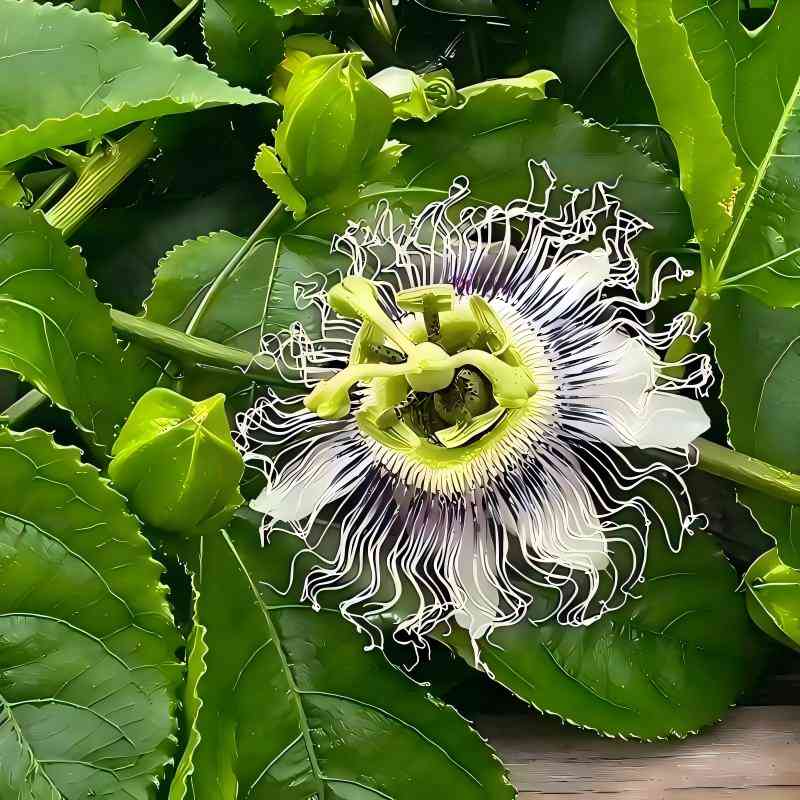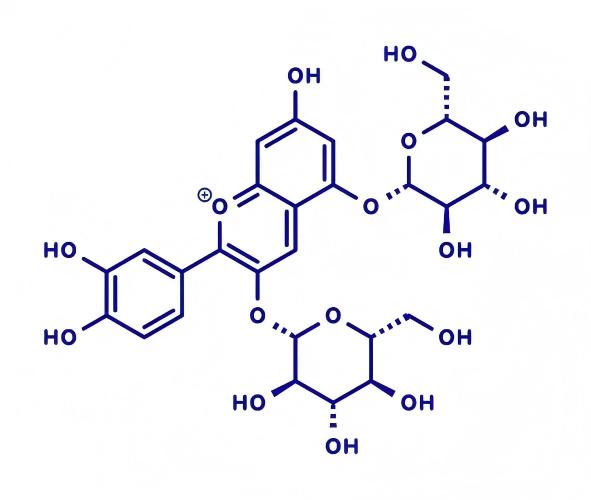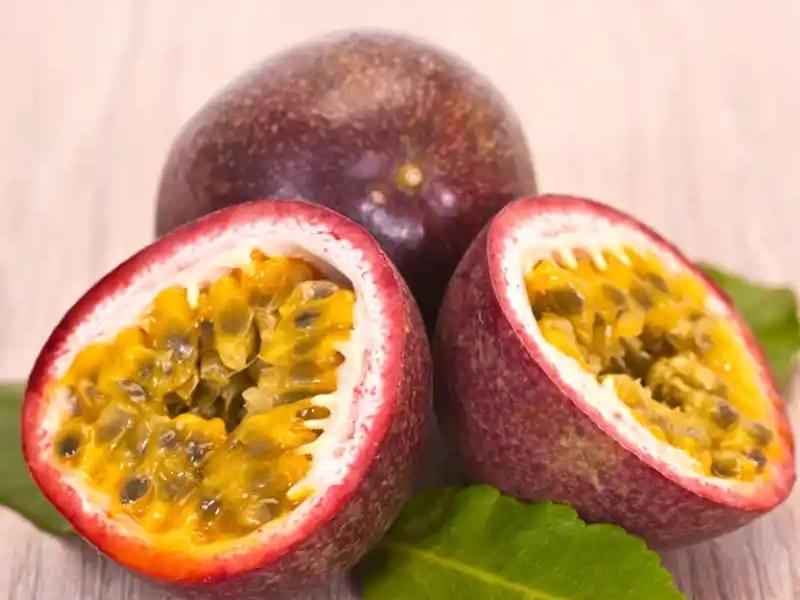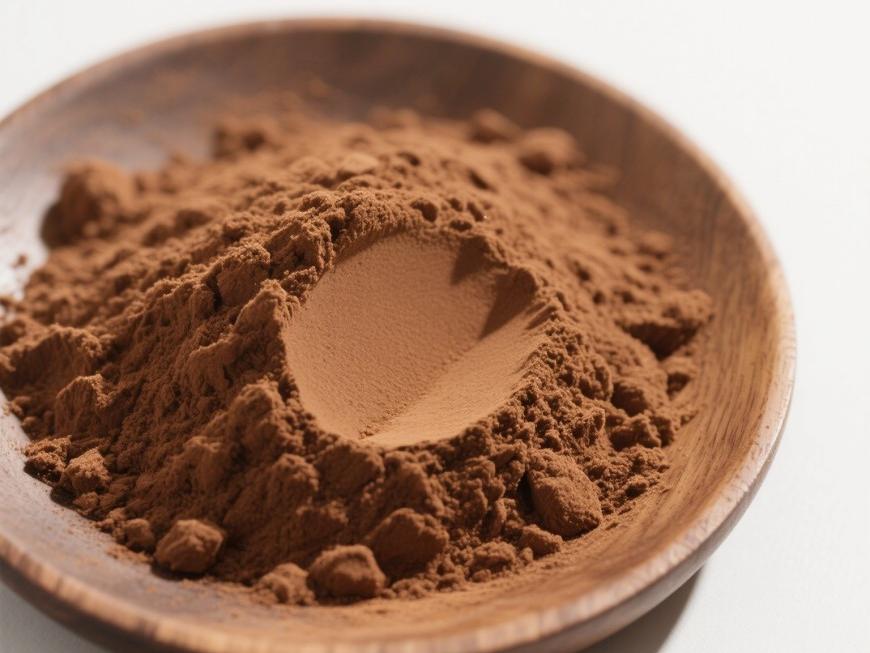Optimized Extraction Process: Green Spring Technology's Passion Fruit Extract Empowers Food Innovation
Passiflora is a unique and nutrient-rich tropical fruit whose peel contains abundant anthocyanins, which are believed to have various potential health benefits [1]. In the current trend of scientific research, in-depth studies on natural plant components are increasingly receiving attention, and the anthocyanin components in Passiflora peel have also attracted widespread interest. To better utilize this natural resource and enhance its application value in the food and pharmaceutical industries, researchers have begun to investigate the effects of different extraction methods on the anthocyanins in passion fruit peel.
1 Overview of Passion Fruit
Passion fruit (Passiflora caerulea L.) is a perennial evergreen climbing woody vine belonging to the Passifloraceae family and Passiflora genus. Its stems are cylindrical, slightly angular, smooth, and hairless; the leaves are papery, with a heart-shaped base, palmately lobed into five deep lobes, the central lobe being ovate-lanceolate, and the lateral lobes slightly smaller, with entire margins and hairless surfaces [2]. Passion fruit is highly valued for its rich nutritional content. It contains 17 essential amino acids for the human body, various vitamins, and over 160 beneficial components, including trace elements, with flavonoids—natural active compounds—being particularly notable [3]. The high flavonoid content makes passion fruit an ideal choice for alleviating irritability and relieving stress.

Passion fruit contains over 132 aromatic compounds. Passion fruit juice, hailed as the “king of juices,” combines the aromas of over 30 fruits, including banana, pineapple, lychee, guava, mango, sour plum, strawberry, and starfruit. Its sweet and tangy taste not only quenches thirst and refreshes the mind but also stimulates appetite and promotes the secretion of digestive enzymes, aiding digestion [4]. Additionally, passion fruit possesses various physiological functions, including lowering blood lipids, preventing arteriosclerosis, reducing blood pressure, anti-cancer, anti-inflammatory, anti-allergic, antioxidant, and anti-aging effects. This makes passion fruit not only unique in culinary enjoyment but also a natural food beneficial to health.
The diverse nutritional components of passion fruit offer people a delicious and healthy option. Passion fruit can be consumed fresh or processed into juice, jam, jelly, wine, and other foods, and also used as a spice additive in the food, beverage, and cosmetics industries. Its unique texture and abundant aromatic compounds provide food with distinctive flavor and aroma, enriching consumers' dietary choices. The peel of passion fruit is also rich in anthocyanins, providing an important natural resource for the modern pharmaceutical and health supplement industries. Discover Our Comprehensive, Compliant, and Consistent Standardized Passionflower Extract Solutions.
2 Importance and Benefits of Anthocyanins
Anthocyanins are water-soluble plant pigments composed of anthocyanin and sugar linked by glycosidic bonds, belonging to the flavonoid class. Flavonoids are a class of secondary metabolites widely found in plants, exhibiting various biological activities. The basic structure of anthocyanins is a benzopyran skeleton. Depending on the type and position of substituents and sugar groups, they can be classified into various anthocyanins, with anthocyanins being one of the main components of anthocyanins. As a flavonoid, anthocyanins demonstrate exceptional nutritional value and health benefits.
Their strong antioxidant capacity is one of their most notable features, effectively scavenging free radicals in the body, preventing cellular oxidative damage, thereby slowing aging and enhancing immunity. The multiple hydroxyl groups on the aromatic ring of anthocyanins can react with free radicals, neutralizing their activity, and providing effective protection for maintaining normal cellular functions. As a natural food pigment, anthocyanins are widely used in the food industry.
The color of anthocyanins can be adjusted according to different pH values and metal ions, producing various shades, which are used for food coloring to enhance color and appeal. Additionally, anthocyanins serve as food additives for preservation, antioxidant properties, flavor enhancement, and taste improvement, thereby enhancing food quality and shelf life. The antioxidant properties of anthocyanins can slow down food oxidation and deterioration, maintaining freshness and nutritional value; aromatic components can enhance the aroma and flavor of food, improving texture and quality.

3 Comparison of different extraction methods for anthocyanin extraction from passion fruit peel
3.1 Water extraction
Water extraction, as a traditional and common method for extracting plant secondary metabolites, has demonstrated unique characteristics in the extraction of passiflora fruit peel anthocyanins. This method primarily relies on the polarity and solubility of water, aiming to effectively extract water-soluble components such as anthocyanins from plant cells through water immersion or heated extraction.
During water extraction, passion fruit peel is first finely ground to increase surface area, facilitating solvent penetration. The ground peel is then soaked in water or heated for extraction. The polar nature of water enables it to effectively penetrate plant cell walls and dissolve components such as anthocyanins. During this process, water molecules interact with the target substances, dissolving them and carrying them out of the plant cells, resulting in an extract containing anthocyanins.
One of the advantages of water extraction is its environmental friendliness, as water is a natural, renewable inorganic solvent, eliminating concerns about organic solvent residues. Additionally, water extraction is relatively simple to perform and cost-effective, making it suitable for large-scale production. It is important to note that due to the limited water solubility of anthocyanins, water extraction may be limited in extraction efficiency, particularly for anthocyanins with higher lipophilicity.
3.2 Ethanol Extraction
Ethanol extraction is an organic solvent-based method for extracting plant secondary metabolites. This method plays a crucial role in the extraction of anthocyanins from passion fruit peel [5]. The principle lies in ethanol's role as an organic solvent with good lipophilicity, enabling it to effectively extract lipophilic components from plant tissues, including anthocyanins. During ethanol extraction, passion fruit peel is first finely ground to increase surface area, facilitating penetration of the extraction solution.
The material is then soaked in ethanol or heated for extraction. Ethanol molecules penetrate into plant cells, dissolving the anthocyanins to form an extraction solution. Due to its strong solvent power, ethanol can effectively extract various secondary metabolites from plant cells, making it highly effective for anthocyanin extraction. One of the significant advantages of ethanol extraction is its high efficiency, enabling the production of anthocyanin extracts with relatively high concentrations. It is important to note that this method involves the use of organic solvents, which may result in residual organic solvent contamination. Careful handling is required during production to address this issue.
3.3 Supercritical Fluid Extraction
Supercritical fluid extraction is an advanced method for extracting plant secondary metabolites, demonstrating exceptional efficacy in the extraction of anthocyanins from passion fruit peel. Supercritical fluids are substances that exist near the critical point between gas and liquid phases under conditions exceeding their critical temperature and pressure. Commonly used supercritical fluids include carbon dioxide.
This method involves controlling temperature and pressure to bring carbon dioxide to a supercritical state, which exhibits high diffusivity and solubility. During supercritical fluid extraction, finely ground fruit peel is exposed to supercritical fluid (typically supercritical carbon dioxide), allowing it to penetrate plant cells. Under supercritical conditions, carbon dioxide possesses both the permeability of a gas and the solubility of a liquid, enabling it to efficiently dissolve components such as anthocyanins in plant cells.
After extraction, the pressure is reduced to rapidly convert the anthocyanins dissolved in supercritical carbon dioxide back into a liquid state. Supercritical fluid extraction operates under mild conditions, eliminating the need for high temperatures or pressures, which helps preserve the natural characteristics of plant secondary metabolites. Additionally, since supercritical carbon dioxide can be recovered and reused after the process, it exhibits strong environmental friendliness. Furthermore, this method does not use organic solvents during extraction, reducing the likelihood of organic solvent residues.
3.4 Microwave-assisted extraction
Microwave-assisted extraction is a method that utilizes microwave radiation to accelerate the extraction of plant secondary metabolites, demonstrating unique advantages in the extraction of anthocyanins from passion fruit peel. This technology leverages the thermal effects generated by microwaves in the medium to rapidly heat plant tissues, promoting cell rupture and facilitating the penetration of the extraction solvent. During microwave-assisted extraction, finely ground peel is placed in a microwave field along with the extraction solvent (typically water or ethanol).
Microwave energy is rapidly transmitted to the plant tissue, causing it to heat up internally, leading to cell wall rupture and facilitating solvent penetration into the cells to dissolve target components such as anthocyanins. This method is characterized by its rapid and efficient nature, reducing extraction time and improving extraction efficiency. One of the advantages of microwave-assisted extraction is its high efficiency, enabling the production of high-concentration extracts in a relatively short time. Additionally, the process is simple to operate and easy to control, facilitating industrial-scale production. However, it is important to note that the application of microwave-assisted extraction may be limited by the penetration depth of microwaves and the characteristics of the sample. Therefore, process optimization is necessary when extracting different plant materials.
3.5 Method Comparison
Different extraction methods, including water extraction, ethanol extraction, supercritical fluid extraction, and microwave-assisted extraction, can effectively extract anthocyanins from passion fruit peel. The following is a comparison of the extraction efficiency of anthocyanins from passion fruit peel using these four methods.

4 Extraction Method Optimization
To ensure the effective extraction of anthocyanins from passion fruit peel, the key objective is to maximize extraction efficiency by adjusting parameters such as temperature, time, and solvent concentration to achieve optimal anthocyanin extraction. Simultaneously, component stability must be maintained. Selecting mild operating conditions is critical during optimization to minimize anthocyanin degradation and inactivation during extraction. The following sections provide optimization recommendations for the four methods.
4.1 Water Extraction Optimization Recommendations
In water extraction methods, to enhance the extraction efficiency of passiflora fruit peel anthocyanins, attention should be focused on extraction temperature and time. Experimental determination of the optimal temperature and time range promotes more complete dissolution of anthocyanins in water, accelerates cell wall rupture, and releases a greater amount of anthocyanins. Regulating the pH of water is also critical. Adding natural acidic or alkaline substances can improve the water solubility of anthocyanins. Introducing high-pressure water extraction technology can enhance water permeability, promote more effective penetration of plant cell walls, increase the release rate of anthocyanins, maintain their stability, and prevent degradation.
4.2 Optimization Recommendations for Ethanol Extraction
In ethanol extraction, optimization recommendations include selecting appropriate ethanol concentrations, adjusting temperature and time, and introducing additives. Through experimentation, determine the optimal ethanol concentration range for anthocyanin extraction, and synergistically adjust temperature and time to promote cell wall rupture and enhance anthocyanin release rates. The introduction of surfactants or enzyme-based adjuvants can improve extraction efficiency by disrupting the structure of plant cell walls, facilitating anthocyanin solubility in ethanol, and enhancing extraction efficiency.
4.3 Optimization Recommendations for Supercritical Fluid Extraction
In supercritical fluid extraction, pressure and temperature should be adjusted synergistically, appropriate amounts of auxiliary solvents should be introduced, and a continuous flow system should be employed. By adjusting the temperature and pressure of the supercritical fluid, its solubility for anthocyanins can be modified, thereby improving extraction efficiency. The introduction of auxiliary solvents enhances the solubility of the supercritical fluid; selecting appropriate types and concentrations can further improve extraction efficiency. A continuous flow system maintains uniform temperature and pressure, enhancing extraction efficiency and preventing performance fluctuations caused by system instability.
4.4 Optimization Recommendations for Microwave-Assisted Extraction
In microwave-assisted extraction, it is necessary to synergistically adjust the microwave frequency and power, introduce appropriate additives, and dynamically control the extraction temperature. By adjusting the microwave frequency and power, their energy can be ensured to fully penetrate plant cells, promoting the release of anthocyanins. Appropriate additives can improve solubility, enhance anthocyanin solubility, and accelerate release rates. Dynamic control of extraction temperature prevents anthocyanin degradation caused by excessive heat, ensuring extraction efficiency and product quality. These optimization measures can significantly enhance anthocyanin extraction efficiency.
5 Conclusion
In summary, through comprehensive research on the extraction methods of anthocyanins from passion fruit peel, we have not only gained a deeper understanding of the characteristics of the plant raw material and anthocyanins but also provided scientific basis for the selection and optimization of extraction methods. These studies not only have practical application significance for the food industry and pharmaceutical field but also provide valuable support for the comprehensive utilization and sustainable development of plant resources. Contact us at helen@greenspringbio.com or WhatsApp: +86 13649243917 for samples and price.
References
[1] Lai Ruiyun; Lin Jianzhong; Zhang Xueqin; Lin Lixia; Zhong Zhanhua; Xie Zhinan. Comparison of chlorophyll fluorescence characteristics in leaves from different crown layers of Passiflora edulis [J]. Chinese Fruit Trees, 2022, (03): 50-53+73.
[2] Li Xia; Chen Haio; Shang Yifan; Wei Ying; Cui Mengjia; Shan Yang; Li Haiyun. “Improvement of intestinal function and hypoglycemic activity by polysaccharides from passion fruit peel” [J]. Journal of Guilin University of Technology, 2021, 41(04): 864-868.
[3] Chen Lingling; Zhao Xingrui; Wang Hongyun; Li Chanjuan; Ma Guangyu; Wang Qiuxiaoman. Research Progress on the Chemical Constituents of Passiflora Plants [J]. Yunnan Chemical Industry, 2021, 48(10): 1-3.
[4] Ding Lei; He Chuanbo; Wei Haocheng; Wu Guohong; Shang Guan Yuchen; Xiong Hejian. Optimization of the extraction process of passiflora fruit peel anthocyanins using response surface methodology [J]. Food Industry, 2021, 42(04):1-4.
[5] Zeng Shaoxiao; Peng Bin; Chen Jie; Zheng Baodong; Du Yanfang. Response surface method for optimizing the extraction process of passiflora fruit peel anthocyanins [J]. Chinese Journal of Food Science, 2014, 14(01): 104-113.
-
Prev
Exploring the Potential of Passionflower Extracts in Functional Foods
-
Next
Bacopa Monnieri Extract: Derived from Nature, Empowering Health Product Innovation


 English
English French
French Spanish
Spanish Russian
Russian Korean
Korean Japanese
Japanese




